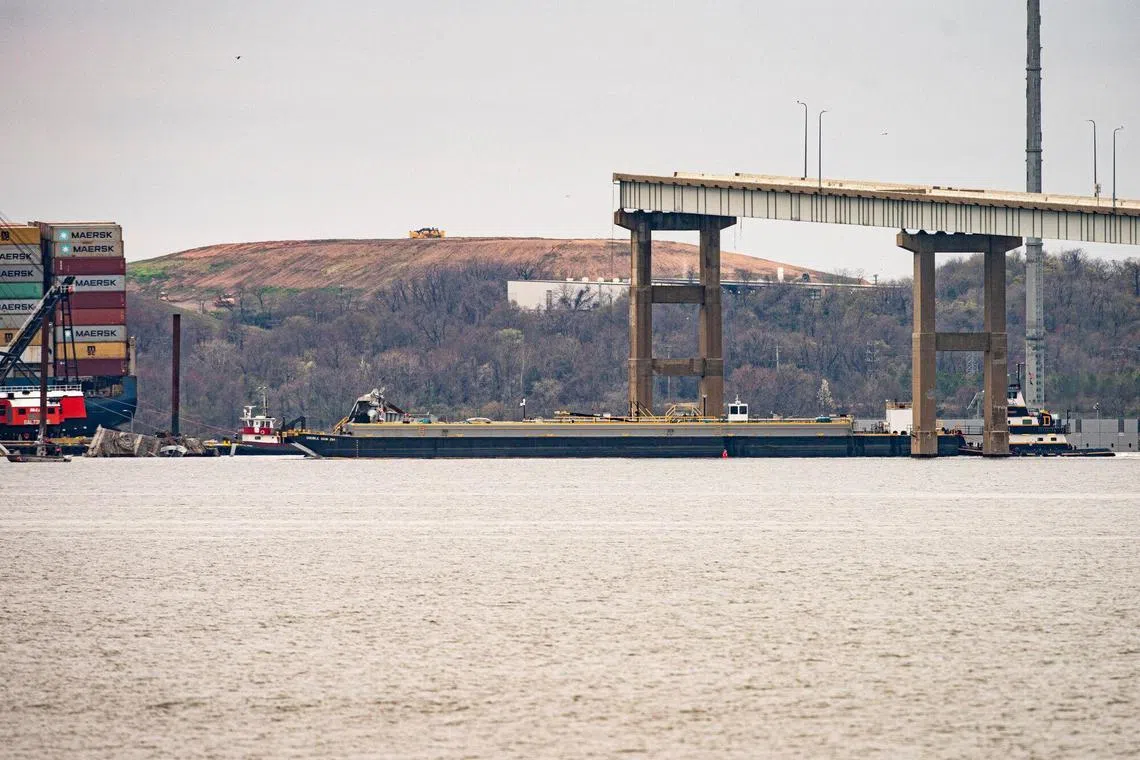Baltimore bridge collapse: Shipowners seek to limit liability; could dirty fuel have played a role?
Sign up now: Get ST's newsletters delivered to your inbox

A fuel barge is pushed by Tugboat Crystal Coast, the first vessel to transit a new temporary alternate channel near the Dali container vessel.
PHOTO: BLOOMBERG
Follow topic:
BALTIMORE – The two Singapore-based companies that own and manage the container ship that knocked down the Francis Scott Key Bridge in Baltimore, in which six lives were lost, have asked a court to excuse them from any liability for the March 26 disaster.
In a petition filed on April 1 before a federal court in the state of Maryland, in which Baltimore is located, the companies said the collapse of the bridge was “not due to any fault, neglect, or want of care”, and sought not to be held liable for any loss or damage resulting from the disaster.
But in the event that they are held liable, they asked that the judge limit the damages to around US$44 million (S$59 million), the current value of the ship and its cargo minus the damage and salvaging cost.
The petition was filed by Grace Ocean that owns Dali – the container ship that slammed into the bridge – and Synergy Marine, which manages it. Both are incorporated and registered in Singapore.
Recounting the March 26 incident, the petition said that the Sri Lanka-bound ship, whose final destination was Yantian in China, had entered the shipping channel at about 1.08am local time.
Seven to 10 minutes later, the ship, which was hauling 4,679 containers of cargo, experienced a loss of power and propulsion.
“The vessel made efforts to regain power, which occurred briefly, but power was lost a second time shortly thereafter. The vessel drifted to starboard, then dropped anchor in response to the loss of power and propulsion,” the petition said. The collision with the bridge occurred at 1.28 am,
The ship, along with its crew of 22 Indian nationals, remains stranded in the Patapsco River. Huge chunks of the bridge, weighing up to 4,000 tons, collapsed on its deck.
A Bloomberg news report characterised the legal move as a common practice by ship owners to reduce liability after catastrophic crashes.
Any claimant suing the Dali owners to recover funds beyond the liability limit would likely have to show that the ship was not seaworthy due to issues such as an incompetent crew or mechanical issues, the report added.
Insurance claims, covering the loss of the bridge and the disruption of businesses using the port, may run into billions of dollars.
The bridge was built in 1977 at a cost of more than US$60 million – or around US$300 million at today’s prices, adjusted for inflation.
Victims of the crash could also file claims against the ship operator.
The petition did not say who the companies believed was responsible for the crash, which is being investigated by the National Transportation Safety Board.
Singapore has sent teams from its Maritime and Port Authority and Transport Safety Investigation Bureau to Baltimore to support the investigations.
The process could take years to complete, though preliminary reports may land earlier.
“We’re still in the recovery phase. The investigation will go on for a fairly long time,” said US Coast Guard Petty Officer Carmen Caver, a spokesperson for the Unified Command and Joint Information Centre set up to coordinate responses and disseminate information about the bridge.
Fuel contamination?
The American media has quoted unnamed officials as saying that “dirty fuel” could be one reason why the ship experienced a blackout and loss of steering before it drifted and slammed into the bridge.
The National Transportation Safety Board has said it would sample and test the fuel for contamination.
Professor Timothy McCoy at the University of Michigan’s Department of Naval Architecture and Marine Engineering told The Straits Times that fuel contamination could be among the many causes of engine failure.
“If the fuel contains too many dirt-type contaminants, it could clog a fuel filter and prevent it from reaching the engine,” he said. Starved of fuel, an engine will stop functioning.
“If it’s not some kind of dirt contaminant, but like water in the fuel, then that could go through the filter and get into the engine. The problem is, of course, an engine can’t burn water.”
But Prof McCoy was doubtful about the dirty fuel theory. “It’s very heavy fuel, it has a lot of impurities. And these engines are designed to burn it,” he said.
Moreover, there are safeguards. “Typically, when you bring fuel aboard, it’s tested,” he said.
“And, ships like these, if they’re in port for just a day or two, they don’t turn off their generators, they stay on the ship’s power. If you’ve had a fuel problem, having it happen at this exact instance seems unlikely.”
Synergy Marine did not reply to a question about when and where Dali was fuelled.
But an NBC News report, citing restricted transponder and satellite tracking data accessed from the UN’s Long-Range Identification and Tracking system, provided some details.
Between Feb 6 and 20, the report said, Dali fuelled up in Zhangzhou and Zhoushan in China and in Busan, South Korea.
It likely also received fuel as it travelled through the Panama Canal to New York, Virginia and Baltimore. But no data was found for this leg of the journey.
There was also no information on the type of fuel Dali received, its origins or its quality.
Contamination of fuel, also called bunker, is not uncommon.
An analysis by Houston-based start-up FuelTrust found that between 2021 and 2022, more than 39 per cent of global bunkers showed discrepancies of 2 per cent or more compared with the amounts stated in their delivery paperwork.
It said the primary issue was the introduction of water into the fuel during the journey from onshore storage tanks to the ship’s bunker tank.
Between 2022 and 2023, over 600 vessels were disabled through fuel problems, despite the fuel being “on-spec”, it said.
Singapore, which is the world’s largest bunker market, tightened its regulations and testing parameters after a 2022 fuel contamination incident which impacted over 200 ships.
Prof McCoy said it was too early to jump to conclusions. “There are dozens of possibilities. It could just be a mechanical failure in one of the engines, it could be an electrical fault,” he said.
“It could be linked to a fire or possible control systems or computer failures.
“Or it could be the result of someone not following proper procedures on board.”


